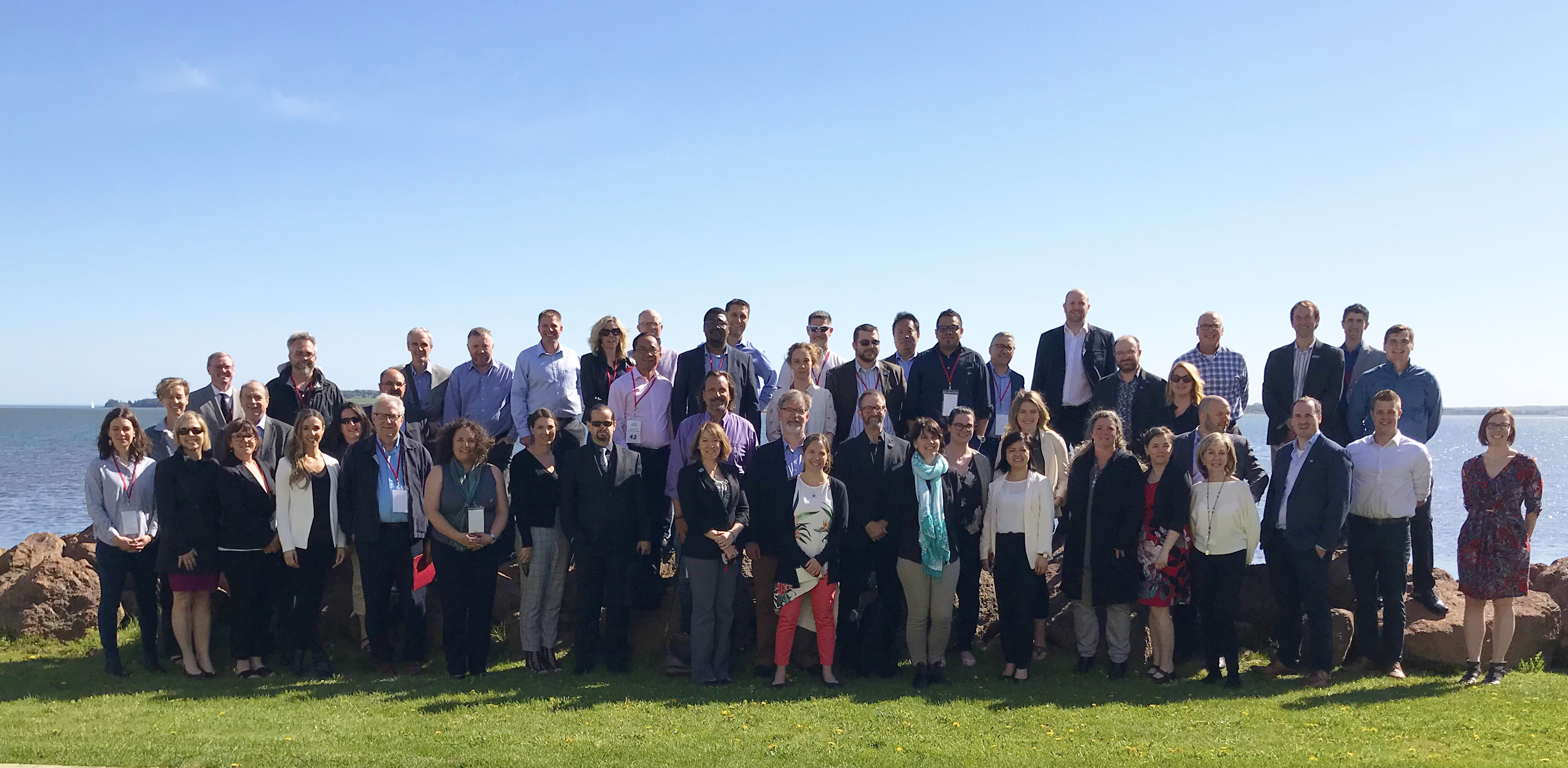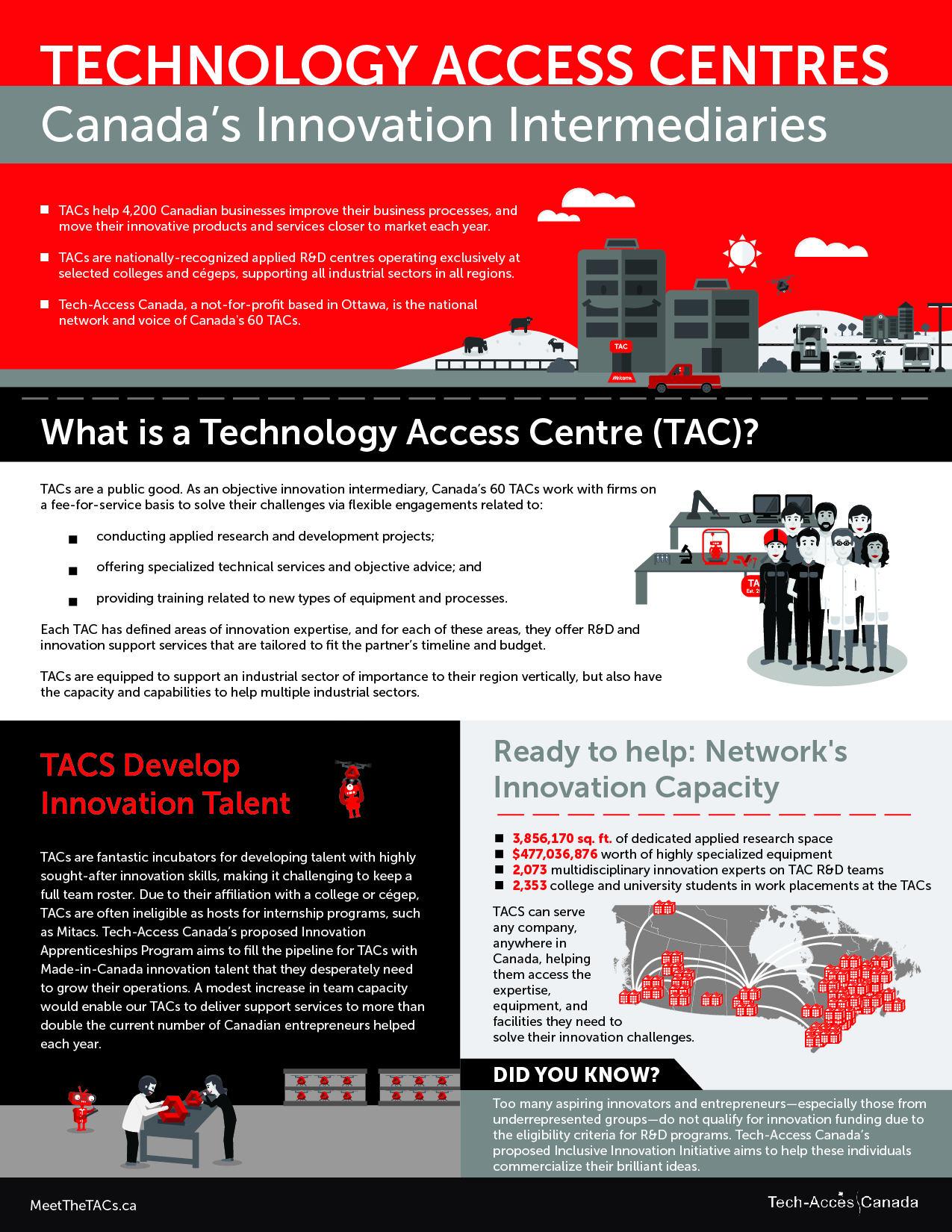Tech-Access Canada is a national, not-for-profit organization passionate about expanding the reach of its 60 NSERC-funded Technology Access Centres (TACs) to make their R&D support services accessible to all entrepreneurs and innovators across Canada and contributing to the development of a more inclusive innovation economy.
Our TAC members are the foremost leaders in college applied research and assisting Canadian entrepreneurs in developing new innovative products and solutions using technology.
Collectively, the TAC network provides Canadian firms with access to:
- Almost 4 million square feet of dedicated innovation and applied research space;
- $477 million worth of state-of-the-art equipment and research facilities; and
- Over 2,000 experts in business innovation and applied R&D with in-depth industry experience.
Vission
Make the innovation and R&D solutions of our member TACs accessible to all Canadian entrepreneurs and businesses to foster inclusive innovation and national economic growth.
Mission
Lead applied research professionals at Technology Access Centres (TACs) to achieve excellence in developing innovative solutions for businesses across Canada.
What We Do
Tech-Access Canada supports the growth, competitiveness, and success of its members by:
- Facilitating the sharing of best practices to help TAC members achieve operational excellence.
- Connecting innovators and entrepreneurs to the TAC(s) within the network with the expertise to advance the development and commercialization of their product or solve their innovation challenge.
- Championing the TACs as major players in Canada’s innovation ecosystem and excellent incubators for top talent and future serial innovators.
- Advocating to senior government officials and heads of agencies on priorities to advance the applied research efforts of the membership and ensure all Canadian innovators can access their R&D services.
- Fostering collaborative partnerships with industry, government, universities, associations, and other innovation stakeholders to advance applied research in Canada.
- Delivering programs that provide opportunities for TAC members to engage in R&D projects with industry partners.
Values
- Excellence: We seek to establish a culture of continuous improvement and exceptional execution to achieve organizational excellence.
- Collaboration: We are stronger together. We collaborate with our TAC members and partners to advance the growth and success of our network, as well as positive innovation outcomes for SMEs across Canada.
- Innovation and Creativity: We embrace creativity and innovative thinking to discover new solutions and fuel the success of our organization.
- Entrepreneurial Spirit: We have a true passion to build, improve, take calculated risks, and execute to achieve greatness
- Equity, Inclusiveness and Diversity: We value uniqueness and harness diversity to drive organizational innovation. We respect and support our employees to be their true selves, so they thrive as individuals and we succeed together as a team.
About the TACs
A Technology Access Centre (TAC) is a state-of-the-art applied research and innovation centre, affiliated with a Canadian college or cégep, that provides companies with access to cutting-edge technology and equipment, as well as a multi-disciplinary team with the expertise to turn brilliant ideas into market-ready products.
TACs offer value-added R&D and innovation services to Canadian businesses—particularly small and medium-sized enterprises (SMEs)—to develop new prototypes, scale-up processes and solve unique business challenges. They also provide customized training for industry to upgrade technical skills, and de-risk the financial investment of implementing new equipment and adopting emerging technologies. They aim to generate innovation and productivity results, while enhancing the competitiveness of their industry partners.
In addition, TACs positively impact the future of education at colleges and cégeps. They provide outstanding experiential learning opportunities for students from their host institutions and recent graduates from universities, by training them on the latest technologies and equipment, providing engaging work opportunities on applied research projects with industry partners, and guiding them to support businesses undertaking innovation and R&D activities in Canada.
Companies that work with the TACs benefit from flexible intellectual property (IP) policies, and have the right to commercialize the research results and IP. TACs also help de-risk the financial investment required when taking on applied research projects by helping businesses to access and leverage government funding programs.
All TACs within the network have won NSERC-designated Technology Access Centre Grants and receive annual funding from NSERC.
How it all started: |
|
|---|---|
1983 |
The Technology Access Centre model is largely based on the very successful Québec centres collégiaux de transfert de technologie (CCTT) model created in 1983. Under the CCTT, the Government of Québec provides stable, predictable funding to maintain and expand the applied research capacity that a college has built in a specific discipline of economic significance in a defined geographic region. Discussions about specialized centres focused on applied research and connected to cégeps began in 1978, and the first CCTTs started in 1983. There are now 59 CCTTs throughout Québec, with no overlap in research areas. |
1998 |
In June 1998, the Canada Foundation for Innovation (CFI) announced the establishment of a $10 million fund designed to help Canadian colleges, institutes and affiliated research centres develop and strengthen their research infrastructure. The College Research Development Fund, approved by CFI’s Board of Directors, was established following extensive consultation with the Association of Canadian Community Colleges (ACCC). Under this new funding mechanism, it was possible for colleges to submit proposals for projects totalling less than $2 million in eligible costs - with a maximum contribution of $800,000 from the CFI. The deadline for the first cohort of proposals was March 1, 1999. |
1999 |
In June 1999 CFI’s Board of Directors approved projects in 15 institutions totalling $7 million under the College Research Development Fund. |
2000 |
In July 2000, CFI’s Board of Directors approved additional projects in 15 institutions totalling $8.5 million under the College Research Development Fund. |
2001 |
The College Research Development Fund (along with a fund for small universities) was wound down and eligible institutions then submitted proposals to the Innovation Fund, by far CFI’s largest program. Of the subsequent $6 billion of CFI funding awarded to 11,000 projects, a total of 15 colleges and cégeps were successful, winning $13 million in non college-specific programming. |
2002 |
Intrigued by the success of CFI’s college-specific program to grow research infrastructure, in the fall of 2002, Senior Management from the Natural Sciences and Engineering Research Council (NSERC) visited 19 community colleges across the country to learn more about the form, nature, and scope of applied research that is being carried out in Canadian colleges. NSERC concluded that the colleges have a significant role to play in building the innovative capacities of communities by helping firms commercialize new discoveries and adopt new technologies. This led to the development of the College and Community Innovation Pilot program. |
2003 |
The College and Community Innovation Pilot program was one of three pilot programs established as result of commitments stemming from NSERC’s Vision, which was approved by Council in October 2003. The rationale for this pilot program was that, while Canada is a world leader in the provision of public funding for research and development (R&D), Canadian businesses and especially small and medium enterprises (SMEs) generally do not invest a significant part of their budget in R&D compared to other Organization for Economic Cooperation and Development (OECD) countries. Colleges were deemed to be well positioned to foster SMEs’ R&D investments. |
2004 |
In 2004, the College and Community Innovation Pilot program - exclusively for colleges – opened a call for proposals. The Pilot program awarded six grants on a competitive basis. A base grant of $100,000 a year for three years was made to successful applicants; funding for years two and three was contingent on successful progress in achieving the goals outlined in the proposal. A mid-term review of the CCI Pilot Program was conducted in 2007. |
2007 |
On March 19, 2007 the federal budget announced that the CCI pilot was made permanent and expanded to additional colleges across the country. Budget 2007 provided $48 million over 5 years to launch the next round of projects. When fully in place, CCIP was designed to support up to 25 college-industry partnerships. |
2008 |
The permanent College and Community Innovation (CCI) program was officially launched in 2008-09 following the Government of Canada (GOC) announcement in Budget 2007, and in the Federal S&T strategy. The program initially only offered the five-year non-renewable Innovation Enhancement (IE) Grant to help colleges build applied research capacity in a specific area. |
2010 |
With NSERC providing project funding, CFI launched the College-Industry Innovation Fund to enhance the capacity of colleges to support business innovation in Canada by providing them with state-of-the-art, industry-relevant research infrastructure to foster partnerships with the private sector in a specific area of strategic priority to the institution. Budget 2010 provided $15 million in additional funding to support partnerships between colleges and businesses through the CCI program. This allowed for the launch of the project-specific Applied Research and Development (ARD) grants; the Applied Research Tools and Instruments (ARTI) grants; and the pilot of the Technology Access Center grants. NSERC launched the pilot of the Technology Access Centre funding program to enhance the R&D activities of established college applied research centres, better supporting the growth of regional firms and industry sectors across the country. The goal was to make companies more productive and innovative by providing access to specialized expertise, technology and equipment at nationally-recognized Canadian colleges and cégeps. |
2011 |
Budget 2011 announced additional funding for NSERC CCI, allowing the launch the College-University Idea-2-Innovation grant, as well as 25 Industrial Research Chairs for Colleges. |
2012 |
The first cohort of nationally recognized TAC designations were awarded to nine college and cégep applied research centres:
|
2013 |
The second cohort of TAC designations were awarded to six college and cégep applied research centres:
The TACs began organizing regular meetings through the informal TACCAT Network to share best practices in business operations and recognized they faced common challenges in driving industry innovation, which could have been better supported by harmonious and standardized approaches to college applied research and the TAC model. NSERC launches third TAC competition. |
2014 |
The third cohort of TAC designations were awarded to six college and cégep applied research centres:
|
2015 |
Red River College hosts TAC Best Practices Forum. The fourth cohort of TAC designations were awarded to four college and cégep applied research centres:
In November, Niagara College in Niagara-on-the-Lake, ON hosts the Niagara Summit, bringing together all of the TACs to share best practices. The TACs decide to formalize their TACCAT network to more efficiently and effectively develop standards of practice on which present and future TACs could usefully base their practice, such that industry across the country could expect common, and high-quality experiences across the varying institutions and sectors served by the TACs. In November 2015 at Niagara College the Terms of Reference for the Technology Access Centres/Centres d'accès à la technologie (TACCAT) Network are adopted. Financial and in-kind support for the network was provided by NSERC, the member TACs, and Colleges and Institutes Canada. |
2016 |
In February, the TACCAT Network hires the inaugural Executive Director to implement the network’s workplan. TACAM hosts the Spring Best Practices Workshop in Winnipeg, MB. The fifth cohort of TAC designations were awarded to five college and cégep applied research centres:
In June, at the member’s Best Practices Workshop hosted by TransBIOTech in Lévis, QC, the formal network launches publicly and unveils its new website, branding, and name: Tech-Access Canada | Tech-Accès Canada. In November, the pilot for the Interactive Visits for SMEs program launches in Ontario with support from NRC-IRAP. SIRT hosts the Fall Best Practices Workshop in Toronto, ON. |
2017 |
Centre d'accès à la technologie en bio-innovation (CAT-B) hosts the Fall Best Practices Workshop in Ottawa Tech-Access Canada launches the Jump Ball Initiative to connect any innovator or entrepreneur in Canada with an innovation challenge, to the TACs ready, willing, and able to assist. The Interactive Visits pilot program continues to grow and gain interest from clients outside of Ontario. Tech-Access Canada represents the TACs by presenting at the Gender Summit 11 North America (GS11NA) conference in Montreal. ICI hosts the Fall Best Practices Workshop in Montreal QC The TACPITS Portal – Tech-Access Canada’s secure online project management portal was launched to assist the Tech-Access Canada team and member TACs with Interactive Visit project tracking and administration. Tech-Access Canada represents the TACs and the Government of Canada by presenting at Intellectual Property Statistics for Decision Makers (IPSDM) conference in Mexico City. The event was co-organized by the Canadian Intellectual Property Office (CIPO), the Mexican Institute of Industrial Property (IMPI), the United States Patent and Trademark Office (USPTO) and the Organization for Economic Co-operation and Development (OECD). |
2018 |
Canada’s Smartest Kitchen hosts the Spring Best Practices Workshop in Charlottetown, PEI. Budget 2018 provides $140 million over five years, to increase support for collaborative innovation projects through the College and Community Innovation Program. Impact of Canada’s TACs as key innovation intermediaries highlighted in budget text. New funding allows NSERC to launch the sixth TAC competition, the first new TAC competition since 2015. Tech-Access Canada delivers TAC to the Future workshop in Winnipeg inviting representatives from member TACs to present operational best practices to an audience of college and cégep attendees interested in applying for the TAC grant. Tech-Access Canada registers as a federal not-for-profit corporation based in Ottawa. Expansion of Interactive Visits program to TACs in Atlantic, Prairies and Pacific regions. Technology Access Centre for Livestock Production hosts the Fall Best Practices Workshop in Olds, Alberta. All TACs from the first cohort are renewed successfully with a second five-year mandate. |
2019 |
NSERC launches seventh TAC competition. Tech-Access Canada delivers in-person TAC to the Future workshop in Niagara for representatives from colleges interested in applying for a TAC, as well as a virtual workshop for cégeps and CCTTs in Quebec. CMQ and Innofibre co-host the Spring Best Practices Workshop in Trois-Rivieres, QC. OECD TIP Knowledge Transfer and Policies project publishes case study on the successful Technology Access Centre model, unique in Canada and to the OCED. Tech-Access Canada represents the TACs by presenting at the Conference of Montreal presented by the International Economic Forum of the Americas. Expansion of Interactive Visits program to TACs in all regions of Canada. The sixth cohort of TAC designations are awarded to seventeen college and cégep applied research centres:
All TACs from the second cohort are renewed successfully with a second five-year mandate. Tech-Access Canada becomes a signatory to the Dimensions charter, committing to encourage greater equity, diversity and inclusion. Centre d'accès à la technologie en bio-innovation (CAT-B) hosts the Fall Best Practices Workshop in Ottawa |
2020 |
The Interactive Visits program is once again open to TACs and SMEs in all regions of the country, that largest program ever. The seventh cohort of TAC designations were awarded to thirteen college and cégep applied research centres:
All TACs from the third cohort are renewed successfully with a second five-year mandate, bringing the Tech-Access Canada family to a solid 60 nationally recognized Technology Access Centres. |
Collaborating with a TAC enables Canadian SMEs to reach the resources they need become high-growth firms, succeeding at home and abroad. These partnerships assist the firm with their technical R&D work, preparing them to enter new markets with new products.
To connect with a TAC to solve your challenge, please visit TACJumpBall.ca. We have a dedicated point person at each of the 60 TACs eager to rapidly respond to your innovation-related inquiry if their TAC is equipped to assist.
For innovative firms, there are several ways to engage with a TAC, each of which can be custom-tailored to meet the needs of the client. These engagements are:
- interactive visits;
- fee-for-service arrangements;
- leveraged projects;
- capstone projects; and
- association-supported projects.
1. Interactive Visits
Interactive Visits provide eligible companies with 20 hours of collaboration with a TAC to solve an innovation challenge, such as:
- Evaluating technical/economic feasibility of new products, processes, or services.
- Short-term R&D assistance and prototype development.
- Providing access to cutting edge technology a company doesn’t have in-house.
- Providing objective scientific, technical and business advice.
The Interactive Visit program is open only to incorporated Canadian for-profit firms with under 500 employees and the potential to grow through innovation, referred by their NRC IRAP ITA or CEA. We strongly encourage and welcome the participation of companies owned by members of traditionally underrepresented groups (women, Indigenous persons, members of visible minorities, and persons with disabilities). Tech-Access Canada gratefully acknowledges the ongoing support of the National Research Council's Industrial Research Assistance Program (NRC-IRAP) to enable this initiative.
2. Fee-for-Service Engagements
Fee-for-service engagements can entail specific technical and business services; training on new equipment and technologies; as well as collaborative applied research projects.
The cost of the engagement will be - by design - at, or above, the market rates of other service providers in the region, but the TAC will assemble the correct team, bring in unique value-added expertise, and the engagement can start the minute the contract is signed. Most of these service, training, and applied research projects can be completed in the rapid timelines the partner needs, often days or weeks.
3. Leveraged Projects
On leveraged applied research projects, the TAC can stretch the partner's R&D dollar further by attempting to access provincial or federal R&D support programs designed to de-risk the innovation investment.
These leveraging programs are competitive, take a considerable amount of time from application to decision, and are not guaranteed to receive leveraging support. However, if successful, the TAC will assemble the correct team of experts and start immediately.
4. Capstone Projects
If the partner's innovation challenge is on a slower track, or the partner is of more modest means, capstone projects are an excellent option.
For a very modest fee, often the cost of supplies and consumables, the TAC will assemble an interdisciplinary team of college student researchers in the last year of their undergraduate program, under the supervision of an instructor, to solve the industry partner's problem.
The project will only take 4 or 8 months, but it must align with the start of the college semester, and is contingent on finding the right mix of willing students to field a team.
Capstone projects have two other significant appeals: de-risking innovation for aspiringly-innovative firms, and letting the firm test-drive potential future employees. What better job interview than 4 months spent learning about a firm and solving their innovation challenge?
Regardless of the project outcome, capstone projects at TACs are also a form of experiential learning that allows college students to acquire valuable innovation skills before they graduate, socializing them to team members from different academic and professional backgrounds, helping create a competitive workforce in the region's key industrial sector.
5. Industry Association Supported Projects
A fourth type of engagement is through industry-association sponsored applied research. In these engagements, an industry association, representing private firms of all sizes in a sector, engages the services of a TAC to tackle an innovation challenge that affects all of their members.
The TAC works individually with a subset of the association's membership on projects, and the results are disseminated to all members for application in their individual operations to improve their productivity and innovation outcomes.
Playing to economies of scale, an engagement of this kind makes much more sense than having each individual member of the association attempt to engage the TAC to conduct duplicate research, especially if there will be no individual proprietary advantage with the results of the project.
TAC Map
TACs List
Address: 350 Sparks St., Suite 909 Ottawa, ON K1R 7S8, Canada
Phone: +1-613-701-0981
Email: info@tech-access.ca
Website: meetthetacs.ca
Our Team


Ken Doyle
Executive Director
Phone: +1-613-366-4252
Email: kdoyle@tech-access.ca
As Executive Director of Tech-Access Canada, the national network of Canada’s 30 Technology Access Centres (TACs), Ken is responsible for ensuring the network achieves its mandate of facilitating the sharing of best practices between member TACs, and promoting the adoption of comparable service excellence standards. Ken actively promotes the Technology Access Centre model to external audiences including industry associations, federal and provincial governments, and the general public. Ken also encourages companies – particularly small and medium-sized firms – to access the services offered by the TACs to get their innovations to market.
Based in Ottawa, Ken brings a deep knowledge of college applied research and over a decade of experience in federal public affairs and policy development for the Canadian college sector. He most recently served as Special Advisor to the Vice-President, Government Relations and Canadian Partnerships at Colleges and Institutes Canada, where he was responsible for strategic files related to college applied research and innovation. Ken holds a Master’s Degree in Public Policy and Administration from Carleton University in Ottawa.

Michelle Gray
Director, External Relations
Phone: +1-613-366-3239
Email: mgray@tech-access.ca
As Director of External Relations, Michelle leads member and stakeholder relations, event management and program development for Tech-Access Canada. She delivers networking opportunities for member TACs to facilitate the sharing and adoption of best practices and service excellence standards to enhance their business performance. She also promotes the TAC network with external stakeholders and key players in Canada’s innovation ecosystem to build new partnerships and raise awareness among SMEs in key industry sectors.
Michelle has over ten years of experience in leading high profile corporate events and research programs, as well as developing new business opportunities and partnerships. She is passionate to help advance business innovation in Canada. Michelle holds a Bachelor of Commerce in Marketing from the University of Ottawa.

Laura Bratanek
Project Manager
Phone: +1-613-867-4069
Email: lbratanek@tech-access.ca
Previously, Laura managed several not-for-profit surgical associations and led communications and operations for a private sector consulting company. She is a Certified Association Executive and holds an M.A. in Communication and a Bachelor of Public Affairs and Policy Management.

Sonia Kilincaslan
Financial Administrator
Phone: +1-613-366-3239
Email: skilincaslan@tech-access.ca
As Financial Administrator of Tech-Access Canada, Sonia is responsible for the organization's finances, preparing financial statements, managing taxation, auditing and ensuring best practices in accounting processes. Furthermore, she prepares budgets, produces financial data for management, and maintains constant guidance and support for the member TACs, external stakeholders and government.
An experienced financial professional, for the past two years, Sonia has assisted not-for-profit organizations with internal accounting standards and procedures. Fluently tri-lingual, Sonia holds a Bachelor of Financial Administration from abroad and an Associate's Degree in Financial Planning from HEC in Montréal.

Bineta Diallo
Team Lead, Events and Programs
Phone: +1-613-366-3239
Email: bdiallo@tech-access.ca
As Team Lead of Events and Programs, Bineta is responsible for delivering the virtual and in-person events and managing innovation programs for the network members of Tech Access Canada. She also promotes the TAC network with external stakeholders and leads members relations.
Bineta has over five years of experience in event and program management, she has previously worked for large multinationals companies delivering events in Canada, the US, and France. Fully bilingual, she is passionate about leading high-profile events. She holds an MBA in Event Marketing and Cultural Communication from INSEEC - Sup de Pub, School of Communication in Paris, France.
Canada All TACs
We want to connect you to the TAC with the capacity, capability, and competence to assist you!
The Jump Ball Initiative (JBI) taps into the innovative capacity and capabilities of the network of Canada’s 60 Technology Access Centres, including over 2,000 business innovation experts and almost 4 million square feet of dedicated applied research space.
Give us five minutes of your time to make the request, and we'll connect you to the TAC that can help.
Canada’s TACs are specialized applied research and development centres affiliated with publicly-funded colleges and cégeps. These demand-driven centres, from across Canada, help innovative small Canadian businesses get more innovative and productive by:
- conducting applied research and development projects focused on company problems;
- offering specialized technical services and objective advice; and
- providing training related to new types of technology, equipment and processes.
We have a dedicated point person at each of the 60 TACs eager to rapidly respond to your innovation-related inquiry if their TAC is equipped to assist.
Simply fill in the inquiry form that applies to you with as much detail as you’re willing to share. The TACs will review it and Tech-Access Canada will promptly provide you with a curated list of TACs who have volunteered to assist, as well as their points of contact.
Merriam-Webster:
jump ball noun
Definition of jump ball
: a method of putting a basketball into play by tossing it into the air between two opponents who jump up and attempt to tap the ball to a teammate
A jump ball is simply a method used to begin or resume play in basketball. It is similar to a face-off in hockey, but since Canada invented both sports, we got our pick of the two and went with Jump Ball.
In basketball, two opposing players attempt to gain control of the ball after an official tosses it into the air between them. While the 48 minutes of the game can be intense, all players are friends and colleagues off the court when the final whistle blows.
At Tech-Access Canada, we wanted to tap into that competitive but collegial spirit with the Jump Ball Initiative for the TACs.



